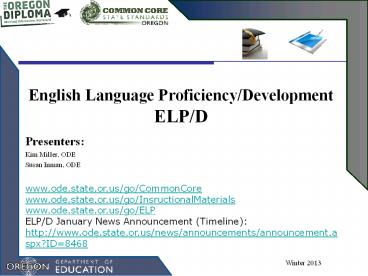English Language Proficiency/Development ELP/D - PowerPoint PPT Presentation
1 / 14
Title:
English Language Proficiency/Development ELP/D
Description:
English Language Proficiency/Development ELP/D Presenters: Kim Miller, ODE Susan Inman, ODE www.ode.state.or.us/go/CommonCore www.ode.state.or.us/go/InsructionalMaterials – PowerPoint PPT presentation
Number of Views:505
Avg rating:3.0/5.0
Title: English Language Proficiency/Development ELP/D
1
English Language Proficiency/DevelopmentELP/D
Presenters Kim Miller, ODE Susan Inman, ODE
www.ode.state.or.us/go/CommonCore
www.ode.state.or.us/go/InsructionalMaterials www.
ode.state.or.us/go/ELP ELP/D January News
Announcement (Timeline) http//www.ode.state.or.u
s/news/announcements/announcement.aspx?ID8468
2
Oregons ELP/D
- Oregon is the lead state in a federal enhanced
assessment grant (ELPA 21) - Grant partners include CCSSO, Stanford
University Understanding Language, and 10
states. - This consortium will have common ELP/D standards
that correspond to the Common Core.
3
Key principles
- The Council of Chief State School Officers
released a Framework for ELP/D Standards that
correspond to Common Core. - This framework is guiding the ELPA 21
consortiums standards. - Council of Chief State School Officers. (2012).
Framework for English Language Proficiency
Development Standards corresponding to the Common
Core State Standards and the Next Generation
Science Standards. Washington, DC CCSSO.
4
Purposes of the ELDP Framework
- The ELDP Framework is a mechanism to help states
understand the relationship between content area
standards of the CCSS NGSS and the developing
language needs of English Learners. - The ELDP Framework creates a procedure that can
be used to align the state ELD standards to the
ELDP framework. By fully aligning to the ELDP
Framework, ELD standards will then correspond to
the language demands of the CCSS and NGSS.
5
Key Principles
- The following slides include information from
Understanding Language at Stanford - http//ell.stanford.edu/sites/default/files/Key20
Principles20for20ELL20Instruction_0.pdf - These slides also provide expectations for
quality instructional materials.
5
6
Understanding Language Six key principles to
support ELLs
- 1. Instruction focuses on providing ELLs with
opportunities to engage in discipline- specific
practices which are designed to build conceptual
understanding and language competence in tandem.
- Learning is a social process that requires
teachers to intentionally design learning
opportunities that integrate reading, writing,
speaking, and listening with the practices of
each discipline.
7
Understanding Language Six key principles to
support ELLs (Continued)
- 2. Instruction leverages ELLs home language(s),
cultural assets, and prior knowledge. - ELLs home language(s) and culture(s) are
regarded as assets and are used by the teacher in
bridging prior knowledge to new knowledge, and in
making content meaningful and comprehensible.
8
Understanding Language Six key principles to
support ELLs (Continued)
- 3. Standards-aligned instruction for ELLs is
rigorous, grade-level appropriate, and provides
deliberate and appropriate scaffolds. - Instruction that is rigorous and
standards-aligned reflects the key shifts in the
CCSS and NGSS. Such shifts require that teachers
provide students with opportunities to describe
their reasoning, share explanations, make
conjectures, justify conclusions, argue from
evidence, and negotiate meaning from complex
texts. Students with developing levels of English
proficiency will require instruction that
carefully supports their understanding and use of
emerging language as they participate in these
activities.
9
Understanding Language Six key principles to
support ELLs (Continued)
- 4. Instruction moves ELLs forward by taking into
account their English proficiency level(s) and
prior schooling experiences. - ELLs within a single classroom can be
heterogeneous in terms of home language(s)
proficiency, proficiency in English, literacy
levels in English and student's home language(s),
previous experiences in schools, and time in the
U.S. Teachers must be attentive to these
differences and design instruction accordingly.
10
Understanding Language Six key principles to
support ELLs (Continued)
- 5. Instruction fosters ELLs autonomy by
equipping them with the strategies necessary to
comprehend and use language in a variety of
academic settings. - ELLs must learn to use a broad repertoire of
strategies to construct meaning from academic
talk and complex text, to participate in academic
discussions, and to express themselves in writing
across a variety of academic situations. Tasks
must be designed to ultimately foster student
independence.
11
Understanding Language Six key principles to
support ELLs (Continued)
- 6. Diagnostic tools and formative assessment
practices are employed to measure students
content knowledge, academic language competence,
and participation in disciplinary practices. - These assessment practices allow teachers to
monitor students learning so that they may
adjust instruction accordingly, provide students
with timely and useful feedback, and encourage
students to reflect on their own thinking and
learning.
12
Oregons ELP/D Criteria
- In January 2013, Oregon adopted Criteria for the
review of ELP/D instructional materials. - http//www.ode.state.or.us/teachlearn/instructiona
lmaterials/ccss-elp-d_criteria.pdf - This Criteria is the basis for evaluating
potential instructional materials for adoption.
13
Timeline for ELP/D standards
- On January 28, 2013, ODE announced Oregon
Continues to Identify New ELP/D Standards
Corresponding to CCSS - http//www.ode.state.or.us/news/announcements/anno
uncement.aspx?ID8468 - This announcement included the following
timeline. - http//www.ode.state.or.us/superintendent/prioriti
es/2012-dec-handout---transition-to-new-elp.pdf
14
Where to get ELP/D Updates Information
- www.ode.state.or.us/go/ELP
- ELP/D January News Announcement (Timeline)
http//www.ode.state.or.us/news/announcements/anno
uncement.aspx?ID8468































